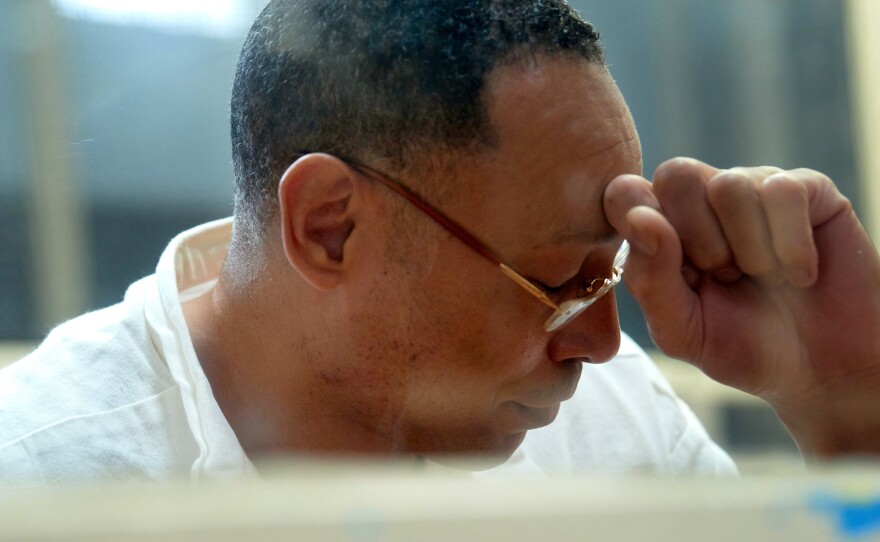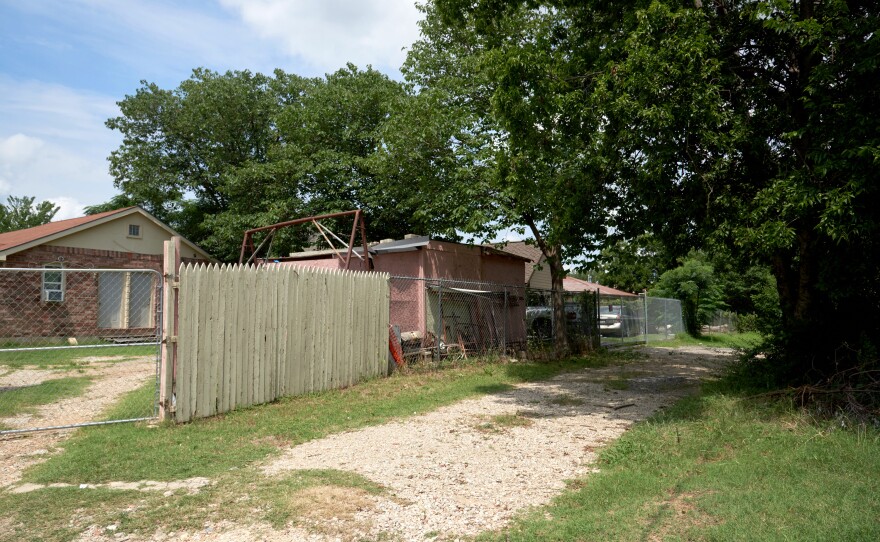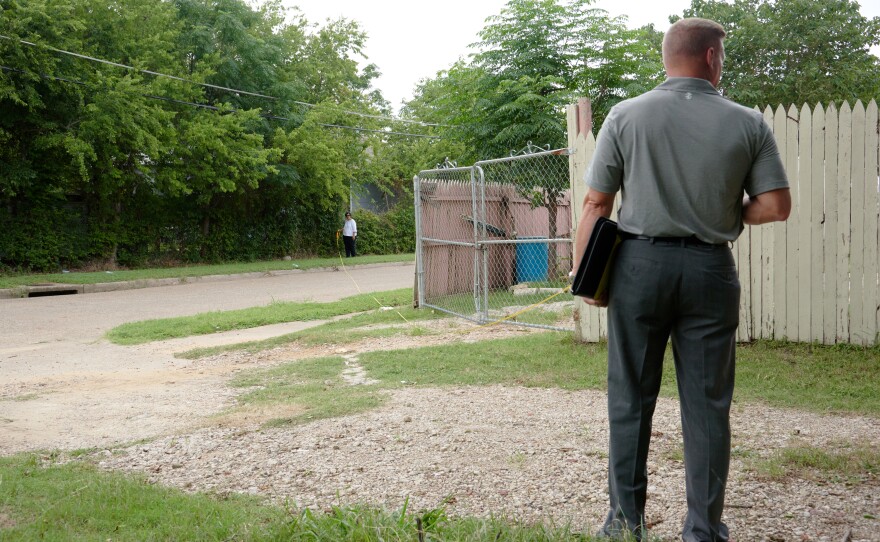Just past 10 p.m. on a summer night, attorney Cheryl Wattley is standing near a quiet street in West Dallas, reconstructing an old crime.
It's a moonless night. One street light and one porch light from a nearby house illumine the scene, nearly identical conditions to the night 30 years ago, when a young man was left to die on the street not too far from here.
Wattley points toward a man standing under the street light, a private investigator named Daryl Parker, as he positions himself in the alley 40 feet away.
"Can you identify him?" she asks.
I squint. It's nearly impossible to see anything.
"You see a silhouette of a man," Wattley says. "You can't even see his face."
On the night of the killing, witnesses said they could see more than a silhouette. They identified Benjamine Spencer and another man running away from the scene. Their testimony helped send them to prison.

But was Spencer guilty? He maintains his innocence. A trial judge even declared Spencer innocent and concluded the evidence that put him behind bars was falling apart. That was 10 years ago. A higher court ruled that was not enough to warrant a new trial. And Spencer remains in a maximum security prison.
This is how he got there.
On March 22, 1987, 33-year-old Jeffrey Young, the acting president of a clothing manufacturing company called FWI, was robbed as he was leaving his office around 9:30 p.m. in a warehouse district of Dallas. Police say two attackers robbed and beat him. They stuffed him in his BMW, drove over the Trinity River to West Dallas, dumped his body on the street, abandoned his car in the alley and fled.

Police got lucky: Three witnesses said they knew the two men from the neighborhood. They identified Spencer and Robert Mitchell as the men who abandoned the car.
"These are not eyewitnesses who were strangers — strangers who all of the sudden had to pick somebody out of a lineup," says Faith Johnson, the current district attorney in Dallas County. "These people knew Spencer."

Four days after the crime, police arrested Spencer. He was 22 years old, newly married, and expecting his first child. He'd had brushes with the law. He'd spent a few days in jail for driving on a suspended license. He'd received six years of probation for driving a car stolen by a friend.
He thought his arrest was a simple mistake, soon to be rectified.
Spencer had an alibi. He and a young woman told police they hung out from around 7:30 p.m. to past midnight the night of the killing. There was no physical evidence connecting him to the crime — no fingerprints, no murder weapon, and no Seiko watch, wedding ring, briefcase or portable TV — items that were taken in the robbery.
"I began to think, 'Well, I didn't commit this offense, the truth is going to come out,'" he said.
He thought he'd be out in a few days. But in October 1987, Spencer was tried for murder. The jury convicted him and sentenced him to 35 years in prison, based on testimony of the three key witnesses and a jailhouse informant.

Then Spencer caught a break. The state's star witness had lied on the stand about whether she received a reward for her information. Spencer was granted a new trial. The state offered him a plea deal: He'd be out in less than 5 years. Spencer's attorney thought he should accept.
"He was saying, 'If you take it to trial, they're going to try to give you a life sentence, and they're likely to get it,'" Spencer recalls. "And I'm like, 'I'm not going to plead guilty to something I didn't do.'"
In the second trial, the state prosecuted him for aggravated robbery and asked for life. The star witness was 42-year-old Gladys Oliver, whose house overlooked the alleyway.
"There's no question that Gladys Oliver's testimony convicted Ben Spencer," said former prosecutor Andy Beach.

He recalls Oliver sitting in a wheelchair in court, eye level with the jury, as she described Spencer getting out of the car and speeding away.
"In the 25 years I tried criminal cases, she was one of the top three or four eyewitnesses of all time," Beach said. "Just her physical presence and her ability to clearly answer questions, and to stand up to cross-examination, it carried the day for us, there's no question."
A jury convicted Spencer a second time, with a sentence of life. Robert Mitchell was convicted a few days later in a separate trial. He, too, maintained his innocence. He died after he was paroled in 2001.
With his verdict, Spencer embarked on a 30-year journey to unearth proof of his innocence. His story illustrates how difficult that can be.
"There's probably not a day that goes by that I don't at least think of Ben," says Jim McCloskey, founder of Centurion Ministries, a group that re-investigates cases of prisoners who may have been wrongly convicted.
Spencer wrote Centurion in 1989. They were unable to take his case for more than a decade. When they finally met, McCloskey says, "I walked away thinking: We can't leave this man behind."
That was 17 years ago. Centurion interviewed more than 100 people, built a case, and then they asked a trial judge for a hearing.
"We thought we had a good shot," McCloskey recalls.
Texas is one of a handful of states that can grant a new trial based on "actual innocence," not just constitutional problems in the original trial. The petition landed in the chambers of Rick Magnis, a newly elected criminal court judge in Dallas.
"I was wary at first," Magnis says in an interview.
The vast majority of exonerations are based on DNA evidence, which was not presented here. But as he read, he became intrigued.

"It started to become persuasive as I looked more and more at the evidence," Magnis says.
In July 2007, he opened an evidentiary hearing. The state's star witness, Gladys Oliver, held firm. But others backtracked.
Spencer's team also presented evidence that they claimed implicated another man, Michael Hubbard. Hubbard was called to testify, but took the fifth.
Finally, they called a forensic visual scientist, who testified it would be impossible for the witnesses to identify Spencer. Under those conditions, you would have to be no more than 25 feet away to discern a face; the closest eyewitness was 93 feet away.
At best, the expert said, the witnesses could have seen a silhouette. The state's expert agreed.

"When you have two [experts] that say none of these three witnesses could have seen what they said they saw," Magnis said, "I felt that was very, very compelling."
So did Alan Ledbetter, the foreman of the second jury. Centurion investigators talked to him in the course of their search for new evidence. The more he listened and researched, the more his doubts grew about Spencer's culpability.
"We worked with what we had, but we were very wrong," he says, as he grows emotional. "So there's an element of guilt, and grief, that I carry for whatever role I may have played in robbing so much of his life from him."
Judge Magnis issued his recommendation that Spencer be granted a new trial to the Court of Criminal Appeals, on the grounds of "actual innocence."
Spencer was elated. "I was very hopeful. I thought that this is it. I'm going home."
But days turned into weeks, months into years, with no word from the Court of Criminal Appeals, the only court with the authority to grant a new trial.
In 2011, he received the grim news. The appellate court denied Spencer a new trial. Judge Lawrence Meyers wrote the unanimous opinion. If this evidence had been presented at the original trial, he explained, it might have created reasonable doubt. But the evidence did not outright clear Spencer.
In an interview with Meyers, he said, "The problem was, there just wasn't newly discovered evidence. That's what really hurt Mr. Spencer the most."
To win a new trial, Spencer would have to find unassailable proof that he's innocent — DNA that's never been tested, for example, or security camera video that's never been seen. It's an incredibly high standard. In fact, Texas judges call it a Herculean burden.
Meyers acknowledges that the bar is so high that innocent people are surely in prison with no recourse. So where does that leave Benjamine Spencer?
Meyers sighs. "Oh, I don't know. Mr. Spencer has been in jail for a long time. Mr. Spencer may be eligible for parole."
Theoretically, Spencer could ask for another new hearing. But his attorney, Cheryl Wattley, says his team threw everything they had into the first hearing. They'd have to start from scratch.

"Ironically, that's the catch-22," she says. "We need new evidence. We need the proverbial breakthrough."
Thirty years after the crime, it's nearly impossible find new evidence.
Gladys Oliver, the one who testified confidently about what she saw, refused to talk about the case.
A second witness is dead. And a third has now back-peddled. That witness testified that he got a clear view of Spencer in the alley. In an interview, he now gives it a 30 percent chance it was Spencer. He says he felt pressured by police to name him.
Another neighbor who was never called at trial says the man ran right in front of her. She's said in an interview that she's "1,000 percent sure" the man was not Spencer.
Even the jailhouse informant, Danny Edwards, has recanted. Edwards had testified that in 1987, Spencer and he briefly shared a jail cell, and that Spencer had said he killed Jeffrey Young. Did Spencer actually say that?
"Naw, he didn't say that," Edwards said in an interview. "He said they was accusing him of doing it. He didn't even know the guy. He ain't even been over there. In fact, he had proof that he wasn't over there that day."
Edwards claimed in court that he did not receive a benefit for his testimony. But state records show he was facing up to 25 years in prison in a separate aggravated robbery case before he talked to lead detective Jesus "Jessie" Briseno. After he gave police his statement about Spencer, the records show his charges were reduced and he walked out of prison in 15 months.
So, if Spencer didn't kill Young, as his some of his accusers now say, who did? Could it have been Michael Hubbard? One of his friends, Kelvin Johnson, recalls that, a few days after the crime, Hubbard mentioned Young's attack and killing.

"These were his exact words: "The white man who they found dead over in West Dallas? I did that, man," Johnson said. "Ben's in prison for something he didn't do."
Johnson was torn because of his friendship with Hubbard, but gave a statement to police about his friend's confession 30 years ago. But he never signed his affidavit, and police didn't believe him.
Johnson eventually testified to all that before Judge Magnis, who found him to be credible.
Hubbard, who's now serving life for a brutal robbery and assault, declined an interview.
Why would investigators believe a jailhouse informant, and disregard the alibi witnesses and others who said the perpetrator was not Benjamine Spencer?
Private investigator Daryl Parker believes it was a classic case of "tunnel vision." That's when police are so driven to solve the crime, they focus on the initial suspect, to the exclusion of other potential leads.
"And then they start making the evidence fit their theory," Parker says, "instead of making their theory fit the evidence."
Detective Jesus Briseno shrugs when he was told that two of his four witnesses have more or less recanted. "It's their conscience, not mine," he says.
Briseno denied pressuring witnesses and says he followed up on Hubbard. He even compared Hubbard's fingerprints with those found in the office and car. They didn't match.
"When we found out he was in jail, we went out there and tried to talk to him and he wouldn't give us the time of day."
And they had a solid suspect already: Benjamine Spencer.
At the maximum security prison, Spencer looks professorial in his wire-rimmed glasses, his hair flecked with gray. He is tall and lanky and still handsome. But he seems a little defeated.
"I'm just at a point where, I'm still hopeful, but at the same time, it's like I'm stuck in a system."
Spencer comes up for parole in February. He's been denied every time in the past, despite a near perfect record.
Jeffrey Young's family opposes his parole. They point out that not one, but two juries convicted him. A story like this re-opens old wounds, and they declined to talk about Spencer's case.
Even without parole, Spencer may have one last hope. It turns out that the crime laboratory in Dallas may have kept fingernail clippings from Jeffrey Young's right hand. There is a chance that Young scratched his killer and captured his DNA beneath his nails.
If the DNA hasn't degraded, it may point to another person, or to Benjamine Spencer. We asked District Attorney Faith Johnson if she would agree to the testing.
"Absolutely," she says, "because we don't want any innocent person to be in prison."
This story was done in collaboration with The Atlantic.
Copyright 2023 NPR. To see more, visit https://www.npr.org. 9(MDAzMjM2NDYzMDEyMzc1Njk5NjAxNzY3OQ001))







